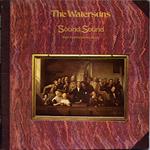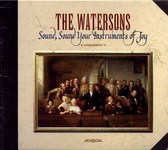> The Watersons > Records > Sound, Sound Your Instruments of Joy
The Watersons: Sound, Sound Your Instruments of Joy
 |
Sound, Sound Your Instruments of Joy Topic Records 12TS346 (LP, UK, 1977) |
 |
Production, design and back cover photographs by Tony Engle
Recorded by John Gill at Riverside Studios, April, June, September, October 1977
Tracks 1 and 6-11 were included in 1990 on the CD reissue of Frost and Fire, track 14 in 2001 on The Carthy Chronicles, and tracks 4, 7 and 9 in 2004 on the Watersons’ 4 CD anthology Mighty River of Song.
Musicians
 In 1977, the Watersons were Lal (Elaine), Mike and Norma Waterson and
Martin Carthy.
In 1977, the Watersons were Lal (Elaine), Mike and Norma Waterson and
Martin Carthy.
On track 7 the accompaniment is by Gabriel’s Horns: Steve Heap: cornet; John Adams: trombone; Tony Engle: C melody saxophone; Alex West: tuba.
Tracks
Side 1
- God Bless the Master (Roud 1066) (3.05)
- While Shepherds Watched Their Flocks (Roud 936) (3.21)
- Windham (Roud 15045) (2.07)
- Heavenly Aeroplane (Roud 7384) (2.23)
- Christian’s Hope (1.58)
- The Bitter Withy (Roud 452) - Mike (2.34)
- Emmanuel (Roud 26895) - Lal and Norma Waterson with chorus accompanied by Gabriel’s Horns (2.48)
Side 2
- Idumea (Roud 6678) (1.48)
- Sound, Sound Your Instruments of Joy (Roud 8366) (4.28)
- Come All Ye Faithful Christians (Roud 815) - Norma (2.28)
- Green Fields (Roud 3385) (2.41)
- David’s Lamentation (Roud 15055) (2.20)
- Morning Trumpet (Roud 15077) (2.10)
- Joy, Health, Love and Peace (Roud 32955) (1.33)
Sleeve Notes
Notes by A.L. L. Lloyd
This is a record to remind us of what we’ve lost since the flood of Victorian hymnals, notably Hymns, Ancient and Modern (1861), pushed out so many noble traditional melodies and replaced them with sanctimonious dirges, genteel but of small spirit. The move towards a truly popular kind of hymnals had started at the outset of the eighteenth century with the young aggressive Isaac Watts and his Hymns and Spiritual Songs, and as the number of dissenting & evangelical groups grew so the use of folksong-based melodies increased, till by the time of the religious revival called the Great Awakening there was a mass of believers prepared to “take the Kingdom of Heaven by storm” with forthright folk hymns to match their militant faith. In this movement, Britain and America were inextricably bound together. A pioneer of the Great Awakening was George Whitefield (1714-1770), an English Calvinist (his famous chapel is in the Tottenham Court Road) who campaigned along the American seaboard among poor dissenters—many of them Quakers and Shakers of British origin—while a brother-preacher, Shubael Stearns, was stumping through the hill-settlements of the Central Appalachians. George Pullen Jackson has remarked that “practically everything these evangelists did was highly offensive to instituted religion. They romped over all denominational lines, preached wherever they could get a crowd, held extravagantly emotional revivals, spread salvation for all through faith and ‘believer’s baptism’.” And notably theirs was an exuberant singing movement. The Baptists and later the Primitive Methodists were nicknamed Ranters because of their unrestrained singing.
Many of the songs in use among the Ranters were set to originally British melodies, transformed into camp meeting spirituals in America, and now returned to their homeland in new and powerful shape. Incidentally, the Primitive Methodists were so strong in the Industrial areas of the Midlands and North that many pioneers of the trade union movement learnt their oratory and organisational skills from experience as lay preachers. On the Northeastern coalfields in the 1830s and ’40s, local revival hymn-writers were also the makers of strike songs.
It should not be imagined that the users of homespun hymns were all rampant revivalists of Holy Roller type. Most were sober folk with a deep feeling for independence in their religious ways, and their hymns reflect their spirit firmly in text and tune. Noble as many of the melodies were, the Victorian hymnbook compilers seemed to consider the folky hymns not fine enough, not respectable enough, and they scornfully pushed them aside. We know some of these pieces from their frail survival in oral tradition among a few country choirs. We know many more through their appearance in hymnbooks used among gatherings of country dissidents in America (some of these, particularly the Southern Harmony of 1835 and the Sacred Harp of 1844, printed in a kind of patent music notation called “shape notes” for the sake of quick learning, are still much in use in the upland South). On this record the Watersons give us a panorama of sacred song, from the deep folklore of wassail songs and vernacular carols, through various folky kinds of meeting-house hymn, and on to exuberant camp meeting pieces. Some pious folk songs or near folk songs that we’ve lost, or that have become unfamiliar, but all well worth restoring to life.
Note by Martn Carthy & Norma Waterson on the CD reissue
We had heard Sacred Harp music previously on record but it was not until 1976 when we were invited to the USA’s Bicentennial celebrations on the Mall in Washington DC, and where we ran into Buell Cobb and his Chapter—taking part in his workshops—that we experienced the actual power of this music. This remarkable man was quite a spur to us when we made our choices for this album.

